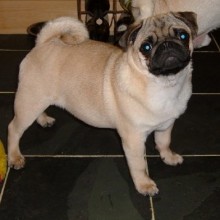Pug
Lifestyle Needs

The Pug has been selected as a companion lap dog. Pugs can easily become overweight couch potatoes, but love short walks. Keeping them trim and fit is important because they can suffer from breathing problems. Pugs need to avoid exercise in hot or humid weather because as a flat-faced breed they are prone to overheating. Great care should be taken when exercising a Pug.
Note that this breed has so many health problems that we do not advise puppy buyers to choose this breed.
‘Please do not buy a flat-faced dog’
Genetic Diversity
(Known as Coefficient of Inbreeding: 'COI'. It should be as low as possible.)
The UK Kennel Club breed average COI is 5.7% - See 'A Beginners Guide to COI'
Gene Pool Size
(Known as Effective Population Size: 'EPS')
133.9
EPS is a measure of how many individuals are contributing genetically to a breed population. It is a measure of the size of the gene pool in a breed. Lower than 100 is considered critical by conservationists and below 50 brings a breed close to extinction. For more information see the Kennel Club article.
Health and Welfare Problems due to Conformation
(Body shape and physical characteristics)
- Due to his extremely flat face (brachycephalic) and round, bulging eyes, the eyes have very little protection and are prone to injuries (Brachycephalic ocular syndrome) – causes chronic irritation and pain.
- Skin fold dermatitis (Having a wrinkly face means that the skin folds can collect dirt and infections, particularly the over nose. Skinfold wrinkles can sometimes also rub on the eyes causing irritation)
- Again, due to the lack of length of muzzle and small nostrils, pugs can suffer with Brachycephalic obstructive airway syndrome (BOAS), causing chronic discomfort and exercise intolerance – if not treated, this can lead to laryngeal collapse.
- The Pug’s screw tail is caused by Hemivertebrae (a deformity characterised by wedge-shaped bones – if elsewhere in the spine it can cause paralysis)
- The Pug’s face and tail shape limits his ability to signal to other dogs.
- Very prone to obesity
BVA/KC Health Schemes: www.bva.co.uk/chs
- Hip dysplasia: breed 5 year mean score 19.8 (parents should be much lower)
- Eye testing in brachycephalic dogs should be routine as a foreshortened head/face can cause substantial welfare problems throughout a dog’s life.
The Pug is one of the 15 high profile breeds designated by the Kennel Club as requiring particular monitoring by reason of visible conditions which may cause health and welfare concerns.
Estimated Breeding Values (EBVs) : No EBVs are currently available for this breed
www.thekennelclub.org.uk/about-ebvs
DNA Tests Available
DogWellNet and IPFD Harmonisation of Genetic Testing for Dogs (HGTD)
www.dogwellnet.com/breeds
- Pug Dog Encephalitis (PDE) This DNA test is a priority for the breed and now provides an evaluation of a dog’s risk of developing the disease: 0 minimal risk, 1 minimal risk (one copy of the gene variant), 2 increased risk (2 copies of the gene variant)
Availability of a DNA test does not mean that it is always necessary or even desirable for breeders to use this test.
Other Breed-Specific Health Screening Schemes
X-ray for Hemivertebrae (note that parents which are radiologically clear of hemivertebra can still be carriers).
The Kennel Club and University of Cambridge Respiratory Function Grading Scheme:
www.thekennelclub.org.uk/rfg-scheme
Breeders must use this Scheme and the accompanying breeding advice to reduce the chances of puppies developing respiratory difficulties as a result of their brachycephalic conformation.
Patellar luxation scheme
Breed club 5 Star Health Scheme
Ask the breeder to show you the certificates for the above tests/screening for both parents. If any of the above tests have not been considered necessary by the breeder (and there may be good reasons), ask her to explain why.
Other Diseases Reported
(For which there are currently no genetic or screening tests for sire or dam)
- Corneal ulcerative disease and other eye problems
- Skin fold dermatitis
- Cancer: Mast cell tumour and others
- Epilepsy
- Entropian
- Keratoconjunctivitis sicca – ‘Dry Eye’
- Dystocia
- Hemivertebrae and other spinal deformities
- Screw tail
Ask the breeder about the medical history of the parents, grandparents and great grandparents. Consider carefully whether to purchase a puppy if some of these or other diseases are in the family line.
Ask about the breeder’s policy in cases of serious genetic diseases occurring to your puppy in later life. Good breeders will request to be informed of such events in order to improve future breeding decisions.
You are strongly advised to buy from a breeder who uses (or is prepared to use) the AWF Puppy Contract and Puppy Information Pack (PIP): www.puppycontract.org.uk
The breeder should also be familiar with the CFSG/DBRG Code of Practice for Dog Breeding
Or the Kennel Club’s Assured Breeders Scheme Standard and Guidance:
Standard PDF | Guidance PDF